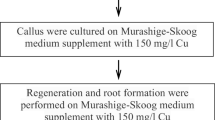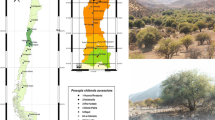Abstract
Deicing reagents are priority soil pollutants in urban ecosystems. Sodium chloride is one of the priority deicing reagents. Sodium chloride is limiting the spread of lawn grass. We first showed the possibility of using environmental biotechnology in urban greening to obtain lawn grasses tolerant of sodium chloride. We have developed a cell selection technology to obtain salt-tolerant lawn grasses. A cell selection scheme with 1% sodium chloride was used. Most of the tested regenerants were more tolerant to NaCl than original plants. The descendants of the studied regenerants demonstrated the preservation of salt resistance. Most of the descendants of the regenerants Agrostis stolonifera retained high decorative qualities under salinity conditions. The tolerance remained in the next five generations. The descendants of the most salt-tolerant clones Agrostis stolonifera demonstrated resistance to 1% sodium chloride concentration in soil. These plants can serve as the basis for the creation of new salt-tolerant varieties.



Similar content being viewed by others
Data availability
All data generated or analyzed during this study are included in this published article.
References
Asensio E, Ferreira VJ, Gil G, García-Armingol T, López-Sabirón AM, Ferreira G (2017) Accumulation of de-icing salt and leaching in Spanish soils surrounding roadways. Int J Environ Res Public Health 14(12):1498. https://doi.org/10.3390/ijerph14121498
Ayaz M, Varol N, Yolcu S, Pelvan A, Kaya Ü, Aydoğdu E, Bor M, Özdemir F, Türkan İ (2021) Three (Turkish) olive cultivars display contrasting salt stress-coping mechanisms under high salinity. Trees. 35:1283–1298. https://doi.org/10.1007/s00468-021-02115-w
Campanelli A, Ruta C, Morone-Fortunato I, Mastro G (2013) Alfalfa (Medicago sativa L.) clones tolerant to salt stress: in vitro selection. Cent Eur J Biol 8:765–776. https://doi.org/10.2478/s11535-013-0194-1
Clarke N, Fuksová K, Gryndler M, Lachmanová Z, Liste HH, Rohlenová J, Schroll R, Schröder P, Matucha M (2009) The formation and fate of chlorinated organic substances in temperate and boreal forest soils. Environ Sci Pollut Res 16:127–143. https://doi.org/10.1007/s11356-008-0090-4
Fan Y, Weisberg PJ, Nowak RS (2014) Spatio-temporal analysis of remotely-sensed forest mortality associated with road de-icing salts. Sci Total Environ 472:929–938. https://doi.org/10.1016/j.scitotenv.2013.11.103 Epub 2013 Dec 15.PMID: 24342100
Gai YP, Ji XL, Lu W, Han XJ, Yang GD, Zheng CC (2011) A novel late embryogenesis abundant like protein associated with chilling stress in Nicotiana tabacum cv. bright yellow-2 cell suspension culture. Mol Cell Proteomics 10:M111.010363
Gałuszka A, Migaszewski ZM, Podlaski R, Dołęgowska S, Michalik A (2011) The influence of chloride deicers on mineral nutrition and the health status of roadside trees in the city of Kielce, Poland. Environ Monit Assess 176:451–464. https://doi.org/10.1007/s10661-010-1596-z
Gladkov EA, Dolgikh YI, Gladkova OV (2014) In vitro selection for tolerance to soil chloride salinization in perennial grasses. Sel’skokhozyaistvennaya Biologiya (Agricultural Biology) 4:106–111
Gladkov EA, Tashlieva II, Gladkova OV (2021) Ornamental plants adapted to urban ecosystem pollution: lawn grasses and painted daisy tolerating copper. Environ Sci Pollut Res 28:14115–14120. https://doi.org/10.1007/s11356-020-11423-6
Gladkov EA, Gladkova OV (2020) Cell selection to increase zinc resistance. P-2061. Meeting abstract. Plant Posters. In Vitro Cell. Dev.Biol.-Animal. 56. https://doi.org/10.1007/s11626-020-00455-4
Gladkov EA, Gladkova OV (2021a) Ecological problems of the use of deicing reagents and lawn grasses. Ecological Readings - 2021. Collection of materials of the XII National Conference, 174-179
Gladkov EA, Gladkova OV (2021b) Cell Selection to Increase Deicing Reagents Resistance. P-2024. Meeting abstract. Plant Posters. In Vitro Cell Dev Biol-Animal 10. https://doi.org/10.1007/s11626-021-00567-5
Glagolev S, Anastasia S, Svetlana S (2018) Basis for application of new-generation anti-icing materials as an efficient way to reduce the accident rate on roads in winter. Transp Res Procedia 36:193–198
He S, Han Y, Wang Y, Zhai H, Liu Q (2009) In vitro selection and identification of sweetpotato (Ipomoea batatas (L.) Lam.) plants tolerant to NaCl. Plant Cell Tissue Organ Cult 96:69–74. https://doi.org/10.1007/s11240-008-9461-2
Kahraman M, Sevim G, Bor M (2019) The role of proline, glycinebetaine, and trehalose in stress-responsive gene expression. In: Hossain M, Kumar V, Burritt D, Fujita M, Mäkelä P (eds) Osmoprotectant-mediated abiotic stress tolerance in plants. Springer, Cham
Kashyap SP, Kumari N, Mishra P, Moharana DP, Aamir M (2021) Tapping the potential of Solanum lycopersicum L. pertaining to salinity tolerance: perspectives and challenges. Genet Resour Crop Evol 68:2207–2233. https://doi.org/10.1007/s10722-021-01174-9
Mastalerczuk G, Borawska-Jarmułowicz B, Kalaji HM (2019) How Kentucky bluegrass tolerate stress caused by sodium chloride used for road de-icing? Environ Sci Pollut Res 26:913–922. https://doi.org/10.1007/s11356-018-3640-4
Marcum KB (2014) Salinity tolerant turfgrasses for biosaline urban landscape agriculture. In: Khan M.A., Böer B., Öztürk M., Al Abdessalaam T.Z., Clüsener-Godt M., Gul B. (eds) Sabkha ecosystems. Tasks for Vegetation Science, vol 47. Springer, Dordrecht. https://doi.org/10.1007/978-94-007-7411-7_15
Munns R (2005) Genes and salt tolerance: bringing them together. The New Phytologist 167:645–663. https://doi.org/10.1111/j.1469-8137.2005.01487.x
Munns R, Tester M (2008) Mechanisms of salinity tolerance. Annu Rev Plant Biol 59:651–681
Minocha R, Majumdar R, Minocha SC (2014) Polyamines and abioti stress in plants: a complex relationship. Front Plant Sci 5:175. https://doi.org/10.3389/fpls.2014.00175
Niedrist GH, Cañedo-Argüelles M, Cauvy-Fraunié S (2021) Salinization of Alpine rivers during winter months. Environ Sci Pollut Res 28:7295–7306. https://doi.org/10.1007/s11356-020-11077-4
Nikiforova EM, Kosheleva NE, Vlasov DV (2014) Monitoring of salinization of snow and soils in the eastern district of Moscow with deicing mixtures. Basic Res 11-2:340–347
Ordóñez-Barona C, Sabetski V, Millward AA, Steenberg J (2018) De-icing salt contamination reduces urban tree performance in structural soil cells. J Environ Pollut Mar 234:562–571. https://doi.org/10.1016/j.envpol.2017.11.101
Patykowski J, Kołodziejek J, Wala M Peer J. (2018) Biochemical and growth responses of silver maple (Acer saccharinum L.) to sodium chloride and calcium chloride. 6:e5958. https://doi.org/10.7717/peerj.5958.
Rout GR, Senapati SK, Panda JJ (2008) Selection of salt tolerant plants of Nicotiana tabacum L. Through in vitro and its biochemical characterization. Biologia futura 59:77–92. https://doi.org/10.1556/ABiol.59.2008.1.7
Qian R, Ma X, Zhang X, Hu Q, Liu H, Zheng J (2021) Effect of exogenous spermidine on osmotic adjustment, antioxidant enzymes activity, and gene expression of Gladiolus gandavensis seedlings under salt stress. J Plant Growth Regul 40:1353–1367. https://doi.org/10.1007/s00344-020-10198-x
Queirós F, Fidalgo F, Santos I, Salema R (2007) In vitro selection of salt tolerant cell lines in Solanum tuberosum L. Biol Plant 51:728–734. https://doi.org/10.1007/s10535-007-0149-y
Roy SJ, Tester M (2013) Increasing salinity tolerance of crops. In: Christou P., Savin R., Costa-Pierce B.A., Misztal I., Whitelaw C.B.A. (eds) Sustainable food production. Springer, New York, NY. https://doi.org/10.1007/978-1-4614-5797-8_429
Sudhersan C, Jibi MS, Ashkanani J, Al-Ajeel A (2012) In vitro screening of potato cultivars for salinity tolerance. Am -Eurasian J Sustain Agric 6(4):344–348
Willmert HM, Osso JD Jr, Twiss MR, Langen TAJ (2018) Winter road management effects on roadside soil and vegetation along a mountain pass in the Adirondack Park, New York, USA. Environ Manag 225:215–223. https://doi.org/10.1016/j.jenvman.2018.07.085
Yuan S, Zhao J, Li Z, Hu Q, Yuan N, Zhou M, Xia X, Noorai R, Saski C, Li S, Luo H (2019) MicroRNA396-mediated alteration in plant development and salinity stress response in creeping bentgrass. Hortic Res 6:48
Zamin M, Khattak AM, Salim AM, Marcum KB, Shakur M, Shah S, Jan I, Fahad S (2019) Performance of Aeluropus lagopoides (mangrove grass) ecotypes, a potential turfgrass, under high saline conditions. Environ Sci Pollut Res 26:13410–13421. https://doi.org/10.1007/s11356-019-04838-3
Zamin M, Fahad S, Khattak AM, Adnan M, Wahid F, Raza A, Wang D, Saud S, Noor M, Bakhat HF, Mubeen M, Hammad HM, Soliman MH, Elkelish AA, Riaz M, Nasim W (2020) Developing the first halophytic turfgrasses for the urban landscape from native Arabian desert grass. Environ Sci Pollut Res 27:39702–39716. https://doi.org/10.1007/s11356-019-06218-3
Zhang Q, Zuk A, Rue K (2013) Salinity tolerance of nine fine fescue cultivars compared to other cool-season turfgrasses. Sci Hortic 159:67–71
Zítkova J, Hegrova J, Keken Z, Ličbinsky R (2021) Impact of road salting on Scots pine (Pinus sylvestris) and Norway spruce (Picea abies). Ecol Eng 159:106–129. https://doi.org/10.1016/j.ecoleng.2020.106-129
Funding
Part of research was carried out within the state assignment of Ministry of Science and Higher Education of the Russian Federation (theme 121050500047-5).
Author information
Authors and Affiliations
Contributions
Conceptualization: Evgeny Aleksandrovich Gladkov, Olga Victorovna Gladkova
Methodology: Evgeny Aleksandrovich Gladkov, Olga Victorovna Gladkova
Experimental work: Evgeny Aleksandrovich Gladkov, Olga Victorovna Gladkova
Writing: Evgeny Aleksandrovich Gladkov, Olga Victorovna Gladkova
Corresponding authors
Ethics declarations
Ethics approval and consent to participate
Not applicable
Consent for publication
Not applicable
Conflict of interest
The authors declare no competing interests.
Additional information
Responsible Editor: Philippe Garrigues
Publisher’s note
Springer Nature remains neutral with regard to jurisdictional claims in published maps and institutional affiliations.
Rights and permissions
About this article
Cite this article
Gladkov, E.A., Gladkova, O.V. Ornamental plants adapted to urban ecosystem pollution: lawn grasses tolerating deicing reagents. Environ Sci Pollut Res 29, 22947–22951 (2022). https://doi.org/10.1007/s11356-021-16355-3
Received:
Accepted:
Published:
Issue Date:
DOI: https://doi.org/10.1007/s11356-021-16355-3




